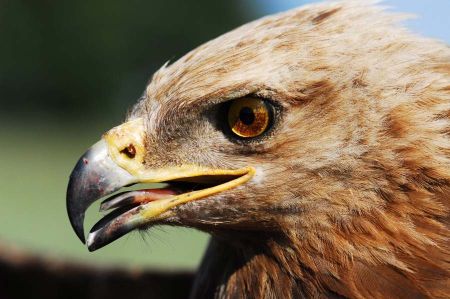Less Spotted Eagles pass by Syria and Israel en route south
- Written by Portal Editor
They have long since disappeared from northern Europe, the long-distance swifts from the lesser spotted eagle family, because they spend the winter in southern Africa.
As experts and users of thermals and air turbulence, the lesser spotted eagle migrates along the coastline of the eastern Mediterranean to cover the seemingly endless distance to South Africa with as little energy as possible. The migration events are therefore concentrated on the well-known focal points of bird migration in south-eastern Europe and the Middle East. Almost the entire European population passes Israel in the fall.
Bird migration payments, another location is at Silifke on the Göksu River
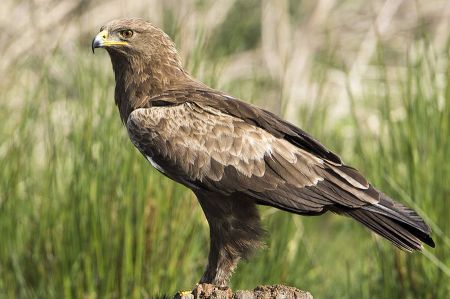 First of all, however, the passage takes place across the straits of the Bosporus near Istanbul, so it is no wonder that there are the best opportunities for recording the numbers of migratory birds. There is also another site for bird counts near Izmir in Sasali, and there is another site at Silifke on the Göksu River. The further train then runs along the eastern Mediterranean coast via eastern Turkey, Syria, Lebanon and Israel into Africa. Some of the Eastern European Lesser Spotted Eagles also migrate south along the east coast of the Black Sea, then through eastern Turkey and also via Syria, Lebanon and Israel to Africa. At the bird observation post in Kefar Kassem, north of Tel Aviv, an average of 104,000 migrants were recorded in autumn, in the "Northern Valleys" further north an average of 71,500 migrants were counted per autumn. At Kefar Kassem, the train starts at the end of August or mid-September at the earliest. The main mass moves between September 20th and October 5th, the median of the departure is between September 26th and 30th. The train ends here in mid-October.
First of all, however, the passage takes place across the straits of the Bosporus near Istanbul, so it is no wonder that there are the best opportunities for recording the numbers of migratory birds. There is also another site for bird counts near Izmir in Sasali, and there is another site at Silifke on the Göksu River. The further train then runs along the eastern Mediterranean coast via eastern Turkey, Syria, Lebanon and Israel into Africa. Some of the Eastern European Lesser Spotted Eagles also migrate south along the east coast of the Black Sea, then through eastern Turkey and also via Syria, Lebanon and Israel to Africa. At the bird observation post in Kefar Kassem, north of Tel Aviv, an average of 104,000 migrants were recorded in autumn, in the "Northern Valleys" further north an average of 71,500 migrants were counted per autumn. At Kefar Kassem, the train starts at the end of August or mid-September at the earliest. The main mass moves between September 20th and October 5th, the median of the departure is between September 26th and 30th. The train ends here in mid-October.
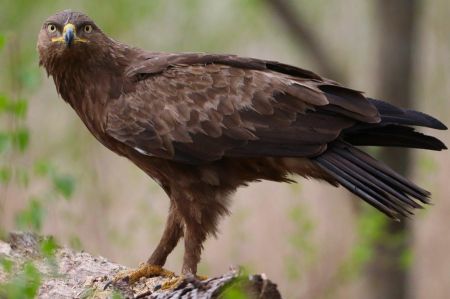 Further migration through Africa could only be clarified in more detail from the mid-1990s using satellite telemetry, a technique that allows the exact location of the animals to be determined. Then, in 1994, four adult males were captured in Germany and Slovakia and tagged with satellite transmitters. They left the breeding grounds between September 1 and 21 and crossed the Bosphorus and Israel between September 14 and October 9. South of Suez, all birds flew almost straight south to Lake Tanganyika in Tanzania, where they arrived in late October. From there, the birds migrated in various southern directions to winter quarters from central Tanzania south to north-eastern South Africa. Most of the population spends the winter in a core area that includes the countries of Zimbabwe, Zambia, Mozambique, northern Namibia and the aforementioned Includes north-eastern South Africa.
Further migration through Africa could only be clarified in more detail from the mid-1990s using satellite telemetry, a technique that allows the exact location of the animals to be determined. Then, in 1994, four adult males were captured in Germany and Slovakia and tagged with satellite transmitters. They left the breeding grounds between September 1 and 21 and crossed the Bosphorus and Israel between September 14 and October 9. South of Suez, all birds flew almost straight south to Lake Tanganyika in Tanzania, where they arrived in late October. From there, the birds migrated in various southern directions to winter quarters from central Tanzania south to north-eastern South Africa. Most of the population spends the winter in a core area that includes the countries of Zimbabwe, Zambia, Mozambique, northern Namibia and the aforementioned Includes north-eastern South Africa.
The journey home began there with single individuals in mid-February
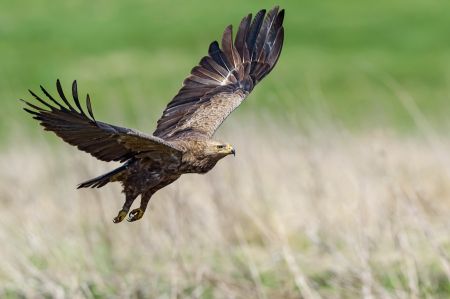 The winter habitats consist primarily of moist, open or only sparsely forested savannas. As far as is known, lesser spotted eagles follow the rain fronts there, which ensure a good supply of food. Lesser spotted eagles also move around extensively in the winter quarters. The winter range of a German lesser spotted eagle equipped with a satellite transmitter covered an area of about 25,000 km² in Zambia, a Slovakian eagle examined over several years searched for different areas in the countries of Zimbabwe, Mozambique and South Africa every winter, laying distances of in two winters at least 2269 km or 1919 km back.
The winter habitats consist primarily of moist, open or only sparsely forested savannas. As far as is known, lesser spotted eagles follow the rain fronts there, which ensure a good supply of food. Lesser spotted eagles also move around extensively in the winter quarters. The winter range of a German lesser spotted eagle equipped with a satellite transmitter covered an area of about 25,000 km² in Zambia, a Slovakian eagle examined over several years searched for different areas in the countries of Zimbabwe, Mozambique and South Africa every winter, laying distances of in two winters at least 2269 km or 1919 km back.
The departure from the winter quarters is so far only known for three animals equipped with satellite transmitters, these began the home migration on February 26th, February 28th and on March 2nd and February 19th (the last two data concerned the same individual in consecutive years ). Two of these eagles returned to the nest site on April 22nd in Slovakia and on April 19th in Germany.
In Israel, the spring migration is hardly recorded, as the main passage runs east and north of the known observation points. In Eilat, only between 40 and 74 home migrants were registered. The home migration began there with single individuals in mid-February, reached its peak at the end of March or beginning of April and was completed by May 10th. In the Central European breeding areas, the birds arrive at the breeding site as early as the end of March, but mostly in the first half of April, so the arrival dates of the two eagles mentioned above were relatively late.
Every year the experts count fewer breeding pairs
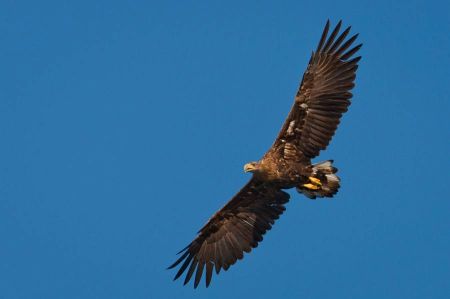 Lesser Spotted Eagles usually lay two eggs, from which two young hatch. Only the strongest will survive. The second chick dies after a few days. It starves to death because it hatches several days after the first one. It is too clumsy when it comes to eating and is fought by the first young, usually even killed on purpose. This behaviour is called Cainism. Animal welfare organisations, such as the NABU Federal Working Group on the Protection of Birds of Prey, therefore carefully removes the second young bird (the so-called "Abel") from some nests and raises it in a release station.
Lesser Spotted Eagles usually lay two eggs, from which two young hatch. Only the strongest will survive. The second chick dies after a few days. It starves to death because it hatches several days after the first one. It is too clumsy when it comes to eating and is fought by the first young, usually even killed on purpose. This behaviour is called Cainism. Animal welfare organisations, such as the NABU Federal Working Group on the Protection of Birds of Prey, therefore carefully removes the second young bird (the so-called "Abel") from some nests and raises it in a release station.
The lesser spotted eagle has been a problem child of nature conservation for a long time. Every year the experts count fewer breeding pairs. There are now only around 90 pairs of the rare eagle left in Germany. For years, NABU has been fighting for the last habitats of the shy bird of prey, buying areas in the breeding grounds and taking care of the protection of its feeding grounds. Nevertheless, the population continues to decline, because hunters are often lurking for them on the migration route and many young birds die before they are adults and return to our breeding grounds.
Please read as well:
